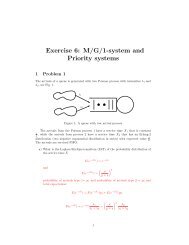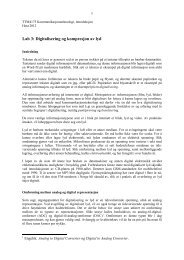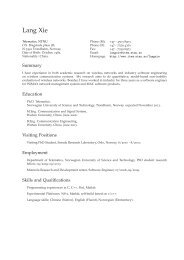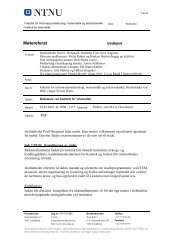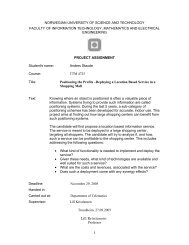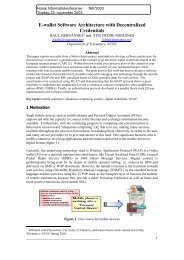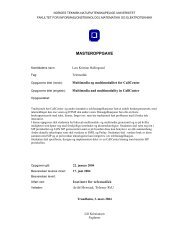Markov Chains
Markov Chains
Markov Chains
You also want an ePaper? Increase the reach of your titles
YUMPU automatically turns print PDFs into web optimized ePapers that Google loves.
<strong>Markov</strong> <strong>Chains</strong><br />
1 Discrete or Continuous <strong>Markov</strong> Chain<br />
What is the difference between a continuous time <strong>Markov</strong> Chain and a discrete <strong>Markov</strong><br />
Chain?<br />
See Ex Moshe Zukerman or Google for more detail.<br />
2 Two state <strong>Markov</strong> Chain<br />
Consider a communications system which transmits digits 0 and 1. Each digit transmitted<br />
must pass through several stages, at each of which there is a probability p that<br />
the digit entered will be unchanged when it leaves. Letting X n denote the digit entering<br />
the nth stage, then {X n , n = 0, 1, .....} is a two state <strong>Markov</strong> Chain.<br />
a) Draw the two state <strong>Markov</strong> Chain and set up the transition probability Matrix.<br />
p<br />
1-p<br />
p<br />
o 1<br />
1-p<br />
Figure 1: State diagrams<br />
[<br />
P = p ij =<br />
p 1 − p<br />
1 − p p<br />
]<br />
.<br />
1
) Solve the state equations to find the limiting probabilities.<br />
π 0 + π 1 = 1<br />
Which implies that<br />
π 0 = π 0 p + π 1 (1 − p)<br />
π 1 = π 2 = 0.5<br />
3 One server with blocking<br />
Rejected Customers<br />
Figure 2: State diagrams<br />
Fig. 2 shows a system that consists of one server that can only handle one customer<br />
at a time. This means that if a customer arrives and the server is busy, the customer<br />
will be rejected. Let I be the number in the system I = 0, 1. Assume that at every<br />
time unit a new customer will arrive with probability α and the probability that a<br />
customer in service will complete service is β. This means that if there is both a<br />
service completion and an arriving customer in a time unit, the system will remain<br />
unchanged.<br />
a) The probability r is the probability that when the system is in state 1, the system<br />
will remain in this state. Determine r.<br />
r = αβ + α(1 − β) + (1 − β)(1 − α)<br />
b) Draw the state transition diagram with all the transition probabilities.<br />
c) Set up the state transition matrix and use this to find the stationary probabilities<br />
P (I = 0) and P (I = 1).<br />
[ ]<br />
0.74 0.25<br />
P = p ij =<br />
.<br />
0.375 0.625<br />
π 0 = 0.6andπ 1 = 0.4<br />
2
1-α<br />
α<br />
r<br />
o 1<br />
β(1-α)<br />
Figure 3: State diagrams<br />
d) Show that you will get the same answer by using cut-equations.<br />
e) What is the expected number of customers in service (the Carried traffic)?<br />
A ′ = 1 ∗ π 1<br />
4 Negative exponential distribution<br />
Let X 1 , ..., X n be independent exponential random variables with mean µ i<br />
E(X i ) = 1 , i = 1, ..., n.<br />
µ<br />
Define<br />
and<br />
Y n = min(X 1 , ..., X n )<br />
Z n = max(X 1 , ..., X n )<br />
.<br />
a) Determine the distribution of Y n and Z n<br />
3
See Moshe Zukerman page 19 for some hints. The variables are independent so :<br />
Use that<br />
n∏<br />
P (Y n > x) = P (X i > x)<br />
i=1<br />
and<br />
n∏<br />
P (Z n ≤ x) = P (X i ≤ x)<br />
Then just plug in P (X i > x = e µ−it and P (X i ≤ x = 1 − e muit<br />
i=1<br />
b) Show that the probability that X i is the smallest one among X 1 , ..., X n is equal<br />
µ<br />
to i<br />
µ 1+...+µ n<br />
, i = 1, ..., n<br />
Using the continuous version of total probability:<br />
P (X i = min(X 1 , ...., X n )) =<br />
∫ ∞<br />
0<br />
∫ ∞<br />
0<br />
∏<br />
P (X i > x)f Xi (x)dx<br />
j≠i<br />
e −(µ1+µ2+..µn)x µ i e −µix dx =<br />
µ 1 + µ 2 + ... + µ n<br />
µ i<br />
5 Continuous Time <strong>Markov</strong> Chain<br />
Do problem 2.21 in Moshe Zukerman.<br />
Birth rate: b i (negative Exponential distribution)<br />
Death rate: d i (negative Exponential distribution)<br />
P(increase by 1): this means that a birth happens before a death. Since the birth<br />
rate and death rate is negative exponential distributions:<br />
Similarly:<br />
d i<br />
P (increase by 1) =<br />
b i + d i<br />
b i<br />
P (decrease by 1) =<br />
b i + d i<br />
See above problem for the derivation of the probability of one negative exponential<br />
bigger than another and also Zukerman p. 19.<br />
4





